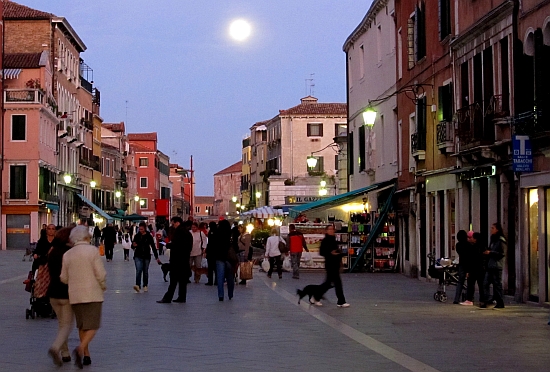
Today, as every year, I indulge in a little orgy of nostalgia for the Thanksgiving traditions, customs, and eccentricities of my native heath. I miss all of it, even the tyranny of the turkey — I know they say we can eat anything we want, probably even tofu or tilapia, but rejecting turkey seems to me to be asking for trouble.
We usually saute a turkey breast and get on with the day. I long ago learned that you cannot duplicate foreign customs with any degree of satisfaction — in fact, trying only makes it worse — so I don’t try. But turkey breast is my propitiatory offering to whatever needs to be propitiated. It’s better than decapitating a live rooster buried in the wheatfield. I’ll get to that in a minute.
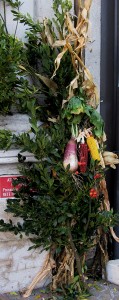
Just because Italy doesn’t have Pilgrim Fathers and Ben Franklin and the Gettysburg Address and so on doesn’t mean that the countryfolk here have no harvest traditions. Au contraire — the country is suffocating with them, as a brief little research has revealed. Venice doesn’t share any of these practices, having devoted all of its forces of gratitude to the Madonna della Salute. But I’m in the harvest mood, so I decided to range afield.
The primary divergence from American customs seem to be that grain, not the bird, has traditionally been the hero of the end-of-cultivation-season celebration, and the majority of these festivals take place toward the end of the summer. Schedule your harvest festival to coincide with the harvest itself? What an idea.
The symbolism, as explained by the author of the website “Luce di strega,” works this way:
The Spirit of the grain is rooted in the pagan traditions of the cycle of fertility, birth and rebirth; the myths of Demetra and Persephone, Ceres and Proserpina, vividly illustrate this reality. Vegetation dies at the end of the summer, returning to the earth from which it will be reborn the next spring. That is, if you perform the correct actions pleasing to the Spirit of the grain.
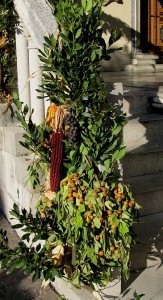
This Spirit was transposed to a sacrificial animal, to improve the chances of pleasing it; this animal was traditionally a bird (rooster, turkey, quail) which lives and hides in the fields, especially in the shocks of harvested grain. The last phase of the harvest would become a sort of race among the farmers to be the first to finish, nabbing a luckless bird, thereby obtaining an appropriate creature to kill as an offering to the Spirit of the grain. Note: The sacrifice has to be an animal because it contains blood, the crucial element in the magic of fertility rituals.
“In some parts of Germany, Hungary, Poland, and Picardy,” writes James George Frazer in “The Golden Bough,” “the harvesters put a live rooster in the grain which is to be harvested last, and they hunt and catch him and bury him up to his neck and decapitate him with the scythe or sickle.”
If this practice should seem extreme, consider that killing a fowl was seen to be better than killing the person who had scythed the last stalks of wheat, which was the original idea.
Have I just completely ruined your enjoyment of your turkey? Perhaps you could regard its position on your table as something a little less drastic — maybe as a sort of propitiation of the Spirit of Black Friday. In any case, there is a definite link, in mythological terms, between the annual ingathering and a cooked (anyway, killed) bird.
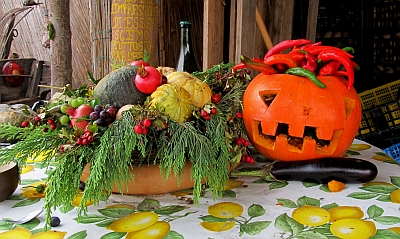
Wandering around the web and YouTube reveals an impressive number of harvest festivals in the countryside and mountains of Italy, out where some connection with agriculture can still be found, though the festivals by now, however deeply felt they may be, seem to have shifted their focus to propitiating the Spirit of Tourism. Which, by the way, never dies, so it never has to be reborn. No blood, just offer money.
Here is a snippet of the famous harvest festival in Foglianise, a small town in the region of Campania about 50 km (30 miles) northeast of Naples. It is held on August 16, which not only coincides with the end of the harvest (at least in the olden days), but is the feast day of San Rocco, patron saint of plague victims. Seeing that he responded to the villagers’ pleas for deliverance from a disastrous pestilence in the 1600’s — yes, it was everywhere — the people of Foglianise have made a special point of honoring him on his day.
The traditional procession involves the predictable dancing, costumes, and music, but the most fantastic element is the series of all sorts of buildings and monuments made of twisted straw, drawn along on carts. The Corn Palace is essentially the same thing, except that it was built to attract settlers, not to invoke fertility. I think. And, of course, it doesn’t move. http://www.youtube.com/watch?v=Y1203SadCYs
I’m not going to go into the symbolism of the cornucopia, but it’s pretty complicated too. It doesn’t involve death, however.
Happy Thanksgiving, whatever you decide to do. Or eat.

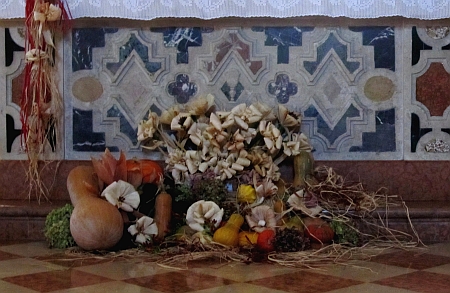
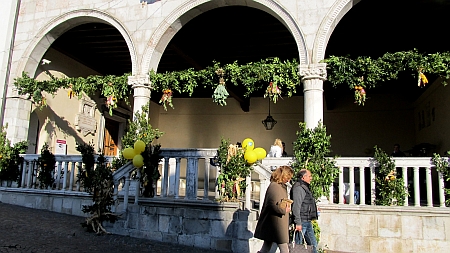

4 Comments
Happy Thanksgiving Erla!
And likewise to you. No turkey today, as it turned out, but if Lino’s expedition has been successful we’ll be eating fresh clams tonight. When I was a kid, the thought would have appalled and revolted me. Now I can hardly wait.
We had chicken cutlets and such. At the market they were roasting a 23 kg(!) turkey for an american family (why is there a distinct lack of residential ovens here?).
That was a huge bird in any case. Hope the clams turned up; one of my favorite foods those are.
I didn’t know there was a distinct lack of residential ovens. Everybody I know has one. Or do you mean an oven the size of a Sherman tank?